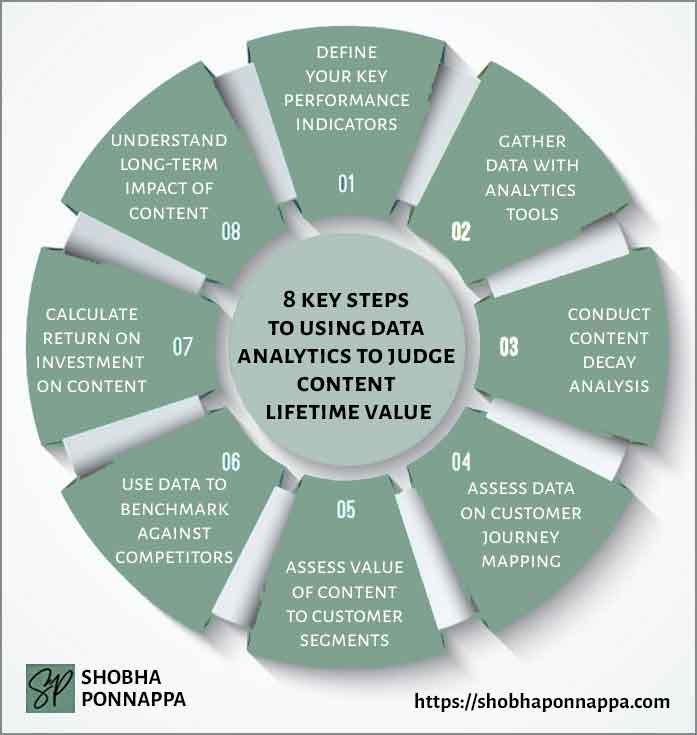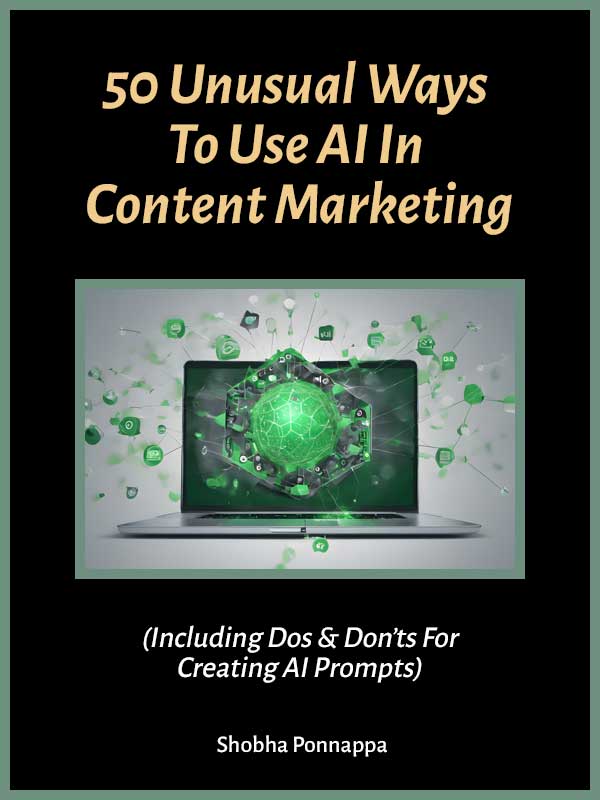
The value of content must not be measured just by immediate engagement or conversions. The true worth emerges over time, reflecting sustained audience interaction and long-term business impact.
However, discerning this nuanced value requires combining data-driven analysis with innovative methods.
In this pursuit, one must not solely rely on traditional metrics. It’s essential to integrate both standard and unconventional data interpretations.
This balance ensures that your content strategy isn’t just effective but also uniquely tailored to stand out in a competitive market, delivering insights that go beyond surface-level statistics.
The lifetime value of content extends far beyond its initial publication and reception, encompassing the ongoing impact it has on audience engagement, brand reputation, and business outcomes.
This value is a critical metric for brands as it provides insight into the long-term effectiveness of content strategies, helping to identify which types of content continually attract and retain customers, contribute to SEO rankings, and ultimately drive revenue.
Analyzing the lifetime value of content allows brands to allocate resources more effectively, focusing on content types that offer sustained returns rather than short-term gains. It also aids in understanding customer behavior and preferences over time, enabling brands to refine their messaging, improve customer experiences, and build stronger relationships.
In a landscape where content saturation can lead to diminishing returns, a keen understanding of content’s lifetime value is essential for brands aiming to maintain relevance and achieve lasting success in their digital marketing efforts.
To accurately gauge your content’s lifetime value, a blend of proven and unusual methods is crucial, reflecting my “Unusual By Strategy” forte. Traditional analytics, like tracking page views, engagement rates, and conversion metrics, offer a solid foundation for understanding content performance.
However, these conventional methods only paint part of the picture. To truly differentiate and add depth to your analysis, incorporating offbeat techniques is key. This could involve assessing the sentiment and emotional impact of content through social listening tools or exploring advanced data modeling to predict future content trends based on current user interactions.
Additionally, experimenting with unconventional content formats or distribution channels can reveal hidden aspects of content value.
This dual approach, combining the reliability of traditional analytics with the fresh perspectives of unconventional strategies, aligns with the mandate of delivering innovative, strategy-driven solutions, ensuring that your content strategy is not just effective but distinctively ahead of the curve.
Leveraging my 40+ years’ experience as a Brand Content Strategist with a penchant for the unusual, I’ve crafted eight ideas that blend time-tested approaches with innovative twists to analyze your content’s lifetime value. These ideas merge reliable methods like KPI tracking and engagement analysis with creative strategies, including sentiment analysis and predictive data modeling.
This unique approach not only harnesses the power of traditional analytics but also infuses them with unconventional techniques, ensuring a comprehensive understanding of content performance. This methodology exemplifies my commitment to offering distinct, strategy-driven solutions that make your content work harder and stand out in a competitive digital landscape.

Establishing clear Key Performance Indicators (KPIs) is a fundamental step in using data to assess your content’s lifetime value, particularly in the realm of content marketing.
KPIs like engagement rates, conversion metrics, and page views provide quantifiable measures of content effectiveness and audience response. For instance, a content marketer might designate ‘average time spent on page’ as a KPI for an informative blog series. Over time, tracking this metric can reveal not just immediate engagement but also how the content continues to perform, indicating its enduring relevance or the need for updates.
Similarly, conversion rates from content-driven campaigns reflect the direct impact on business goals. By selecting KPIs aligned with specific objectives, such as brand awareness or lead generation, marketers can gain insights into the long-term value and ROI of their content strategies.
This approach ensures a focused analysis, allowing for strategic adjustments and content optimization based on concrete, data-driven feedback.

Consider the idea of “Sentiment Shift Analysis.” It can be an unusual enhancement when defining your KPIs. Instead of solely focusing on quantitative metrics like page views or click-through rates, this method involves analyzing the changes in audience sentiment over time. For instance, in the earlier example of tracking ‘average time spent on page’ for a blog series, incorporate sentiment analysis tools to gauge the emotional response of readers to each post.
By examining comments, social media interactions, and even tone changes in user feedback, you can gain deeper insights into how content is resonating emotionally with your audience, adding a new dimension to understanding its lifetime value. This approach not only quantifies engagement but also qualitatively assesses content impact, making KPIs more comprehensive.
Implementing and utilizing analytics tools is crucial for gathering the data necessary to evaluate your content’s lifetime value. These tools, such as Google Analytics, provide comprehensive insights into user behavior, engagement patterns, and content performance.
For example, a content marketer can use Google Analytics to track how a specific blog post is performing in terms of user engagement. By monitoring metrics like page views, bounce rates, and average session duration, they can assess not just the immediate popularity of the post but also its ability to retain audience interest over time.
This data is invaluable for determining whether the content continues to attract and engage users long after its initial release, contributing to a deeper understanding of its ongoing value.
Such insights enable content marketers to refine their strategies, focusing on creating content that not only captures immediate attention but also maintains relevance, thereby maximizing its lifetime value.

Consider the idea of “Predictive Engagement Mapping.” Beyond traditional data gathering, this unusual enhancement involves using advanced analytics tools to forecast future engagement trends based on current data patterns. For instance, in the case of using Google Analytics to track a blog post’s performance, Predictive Engagement Mapping would use AI algorithms to analyze current engagement metrics like page views and session durations.
It would then predict how these metrics might evolve, identifying potential peaks or declines in interest. This method allows content marketers not only to understand the present value of their content but also to anticipate its future impact, enabling proactive strategy adjustments for sustained content relevance and value.
Content decay analysis is vital for understanding when and why previously successful content starts losing its impact over time, a crucial aspect in measuring its lifetime value.
For instance, imagine a content marketer who notices a gradual decline in traffic and engagement on a once-popular tutorial blog post. By conducting a content decay analysis, they can pinpoint the moment when the decline began and investigate the causes, such as outdated information, changes in search engine algorithms, or shifts in audience interest.
This analysis helps in identifying content that needs updating or repurposing to regain its effectiveness.
Regularly performing content decay analysis ensures that the content remains relevant and continues to contribute positively to the overall content strategy, maximizing its long-term value and keeping the brand’s digital presence strong and current in a rapidly evolving online environment.

Consider the idea of “Cultural Relevance Mapping.” It could be an unusual enhancement to content decay analysis. This method involves evaluating how shifts in cultural trends and public interests affect the relevance of your content over time. For instance, in the scenario of a declining tutorial blog post, Cultural Relevance Mapping would entail analyzing current cultural and industry trends to assess their impact on the content’s relevance.
Perhaps a new technology or a shift in industry practices has made parts of the tutorial obsolete. By identifying these cultural shifts and their influence on content performance, you can proactively update your content to align with current trends and interests, thus revitalizing its appeal and extending its lifetime value.
Assessing customer journey mapping through data is a critical step in understanding how different pieces of content influence a customer’s progression from awareness to decision-making.
By tracking user interactions across various content types, marketers can identify which materials are most effective at each journey stage. For example, a marketer might discover through data analysis that introductory blog posts are great at generating initial interest, while in-depth guides are more effective at converting interest into actions, such as newsletter sign-ups or purchases.
This data-driven approach to mapping the customer journey allows for a more strategic allocation of resources, focusing on creating and optimizing content that effectively guides potential customers through each stage of their journey.
It also highlights gaps or weak points in the content strategy where potential customers might be lost, enabling marketers to create targeted content to better serve and convert their audience.

Consider the idea of “Emotive Transition Tracking.” It could be an enhancement to using data in customer journey mapping. This approach involves analyzing not just the clicks and views, but also the emotional responses elicited by content at each stage of the customer journey. For instance, in the scenario where blog posts generate initial interest and guides drive conversions, Emotive Transition Tracking would delve into the emotional shifts between these stages.
By employing tools like sentiment analysis on user comments or engagement reactions, you can gauge whether the content is effectively nurturing a positive emotional journey from curiosity to trust. This deeper insight allows for a more nuanced approach to content optimization, ensuring that it not only informs and convinces but also resonates emotionally with the audience, enhancing its impact on the customer journey.
Assessing the value of content to different audience segments is a crucial aspect of understanding its lifetime value, particularly in content marketing where audience needs and preferences can vary widely.
For example, a digital marketing agency might create a range of content, from beginner-level SEO guides to advanced social media strategies. By using data to segment their audience based on expertise and interests, the agency can determine which content resonates most with each group.
Beginners may engage more with the basic guides, indicated by higher page views and longer time spent on these pages, whereas advanced users might show greater interest in the in-depth articles, as reflected in higher engagement and sharing rates.
This segmentation allows for a more tailored content strategy, ensuring that resources are invested in creating content that not only attracts but also retains and adds value to each segment of the audience, thereby maximizing the overall effectiveness and lifetime value of the content.

Consider the idea of “Psychographic Interaction Mapping.” It could be an unusual enhancement to assessing the value of content to audience segments. This method goes beyond traditional demographics to analyze audience interests, attitudes, and lifestyle choices, providing a more nuanced view of content impact. In the example of a digital marketing agency segmenting content for beginners and advanced users, Psychographic Interaction Mapping would delve into the underlying motivations and aspirations driving each group’s engagement with specific content.
For instance, beginners might engage more with SEO guides due to a desire to learn new skills efficiently, while advanced users might prefer in-depth articles that align with their goal of staying ahead in the industry. This approach allows for a deeper understanding of why different segments interact with content the way they do, enabling more targeted and impactful content strategies.
Utilizing data to benchmark against competitors is an essential strategy in understanding your content’s lifetime value in the context of the broader market.
For example, a company specializing in eco-friendly household products might analyze competitors’ content strategies to understand how their own content stacks up in terms of engagement and reach. By examining metrics such as shared keywords, backlinks, social media mentions, and search engine rankings, they can identify gaps in their content strategy and areas where competitors are excelling.
This comparison not only highlights the strengths and weaknesses of their own content but also provides valuable insights into industry trends and audience preferences.
With this information, the company can refine its content strategy to better meet audience needs and stand out in the market, ultimately enhancing the long-term value of its content by making it more relevant and competitive.

Consider the idea of “Competitive Narrative Analysis.” It would be an unusual enhancement for benchmarking against competitors. This approach involves studying not just the quantitative data of competitors’ content, such as engagement metrics and backlinks, but also qualitatively analyzing the storytelling methods and narrative styles they use.
For instance, in the case of the eco-friendly household products company, alongside traditional benchmarking methods, they would examine how competitors craft their brand stories, the emotional appeals they use, and the unique angles they adopt in their content. This deeper analysis can reveal insights into why certain content resonates with audiences and how to differentiate their own content narrative, providing a competitive edge in both engagement and brand distinctiveness.
Calculating the return on investment (ROI) of content is a critical practice for quantifying its effectiveness and justifying content marketing expenditures.
For instance, a software company might analyze the ROI of an instructional video series by comparing the production and promotion costs against the tangible business outcomes it generated, such as increased software sign-ups or enhanced customer engagement.
This process involves tracking various metrics, including direct sales, lead generation, and website traffic attributed to the content. By assigning monetary values to these outcomes, the company can derive a clear picture of the content’s profitability.
This ROI calculation not only helps in understanding the current value of the content but also guides future content development strategies, ensuring resources are allocated to the most impactful types of content. Such data-driven decisions are essential for optimizing content marketing strategies and ensuring long-term business growth.

Consider the idea of “Engagement Value Attribution.” It could be an unusual enhancement for calculating the ROI of content. This method goes beyond traditional financial metrics, assigning value to the levels and types of audience engagement a piece of content receives. For the software company’s instructional video series, this could involve evaluating how deep the engagement goes, like the number of meaningful conversations sparked in the comments, the quality of customer feedback received, or the increase in social media mentions.
By quantifying these engagement factors and attributing a monetary value to them, the company gains a more holistic view of the content’s ROI, encompassing both tangible and intangible benefits, and thus providing a more comprehensive understanding of the content’s true value and impact.
Understanding the long-term impact of your content is essential for developing a sustainable content marketing strategy. For example, a health and wellness blog might find that certain articles on nutrition continue to attract significant traffic and engagement months or even years after publication.
This enduring appeal can be attributed to the evergreen nature of the content, which remains relevant and useful over time. By analyzing metrics such as sustained traffic, ongoing social shares, and consistent ranking on search engines, the blog can identify which topics or types of content have long-term value.
This insight allows for strategic decisions about where to focus future content efforts, such as producing more evergreen pieces that have proven to maintain relevance.
Understanding this aspect of content performance not only informs immediate content strategy but also shapes the brand’s approach to content creation, focusing on building a repository of valuable, lasting material that continues to serve the audience and contribute to business goals over time.

Consider the idea of “Content Lifespan Forecasting.” This could be an unusual enhancement to understanding the long-term impact of your content. This technique involves using predictive analytics to forecast the potential longevity and relevance of content based on current trends and historical data. For the health and wellness blog, this could mean analyzing patterns in past evergreen articles, like those on nutrition, to predict how similar future content might perform.
By assessing factors such as topic durability, evolving audience interests, and search trend predictions, the blog can not only gauge the lasting impact of existing content but also strategically plan future topics that are likely to maintain relevance and continue attracting traffic in the long term. This proactive approach allows for more efficient resource allocation and content planning, ensuring sustained value and impact.
Strategic use of data is essential: Effectively analyzing your content’s lifetime value requires a strategic approach to data. Utilizing analytics tools, understanding customer journey mapping, and assessing content decay are all crucial for a comprehensive view of how your content performs over time.
Balance of traditional and innovative methods: To maximize content impact, it’s important to blend traditional content strategy methods with innovative enhancements. Techniques like Sentiment Shift Analysis, Predictive Engagement Mapping, and Content Lifespan Forecasting provide deeper insights, allowing for more nuanced and effective content strategies.
Continuous evolution and adaptation: The long-term success of content relies on continuous monitoring, analysis, and adaptation. Understanding the evolving needs of different audience segments, benchmarking against competitors, and recalculating ROI ensures that content remains relevant and effective, driving sustained value for the brand.

"As a Content/Brand Specialist, and SEO/UX Writer, I can help transform your brand's online presence. I can lift it with innovative ideas to take it to an enviable position. Let's collaborate to create a captivating brand story, engage your audience, boost your online visibility, and increase your ROI. Take the next step towards your brand content success and contact me today."
Shobha Ponnappa
I Bring You:
Content Marketing That’s “Unusual By Strategy” … Tips, Tricks, Tactics, Techniques, Trends, Training.
Get my weekly ContenTracker Newsletter packed with loads of content marketing ideas – proven and unusual.
Get a free download of my ebook on “50 Unusual Ways To Use AI In Content Marketing” … and transform your success.

Just fill in the form to join my community … we have big and small brands for company. You’ll stay on the speedway to growth.
KEY TOPIC CATEGORIES COVERED ON THIS SITE:
COPYRIGHT © 2024. SHOBHAPONNAPPA.COM. ALL RIGHTS RESERVED.

Just fill in this form and get this awesome ebook in your email inbox. Plus … each week you’ll receive my ContenTracker Newsletter that brings you tips, tricks, tactics, techniques, trends, and training on the latest in content marketing.